Think you can’t bake artisan sourdough bread at home? Think again! Sourdough Bread: a Beginner’s guide is your go-to recipe resource for simple, easy sourdough bread without kneading. Make the dough in the morning or at night- it will come together in under 10 minutes.
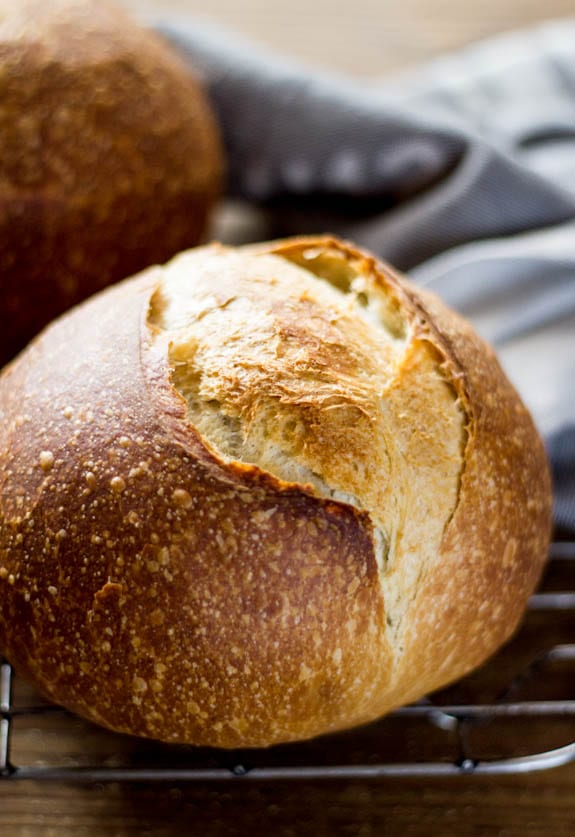
In 2013, my resolution was to bake more bread.
I researched, tested and baked countless loaves with both good and mixed results. My journey began with this no-knead artisan bread recipe and eventually, I worked my way up to the holy grail: Sourdough. My passion for creating easy sourdough bread recipes and preserving traditional culinary arts inspired my bestselling book Artisan Sourdough Made Simple which has connected me to like-minded bakers all over the world! Lucky me 😉
If you’re curious about sourdough bread (and don’t know where to begin) trust me, you’re in the right spot. My beginner sourdough bread recipe has been THE MOST popular recipe on my blog for over a decade and continues to earn millions of page views a month. Welcome to the journey!
What You’ll Learn
In this tutorial, you’ll learn how to make simple sourdough bread with step-by-step recipe instructions and videos for guidance. There’s no kneading involved, and a bread machine or a stand mixer is not required. My sourdough bread recipe is perfect for beginners. I’ll explain a complex topic in simple terms without the stress! But before you dive in, here’s a secret: sourdough bread is more than just a recipe… it’s an understanding.
There are similar sourdough bread recipes out there and yet no two loaves look alike. The process is all about method, timing and personal touch. Use this tutorial as a guide and make your own adjustments as you go. Once you have a few loaves under your belt, the process will become an imminent rhythm, and in the end, you will have created your very own masterpiece that is the ultimate reward. Just don’t forget to eat your mistakes (might I suggest homemade sourdough breadcrumbs)?
Jump To
- Sourdough Bread Recipe
- Step by Step Instructions
- Sourdough Starter 101
- Sample Baking Schedule
- Sourdough FAQ
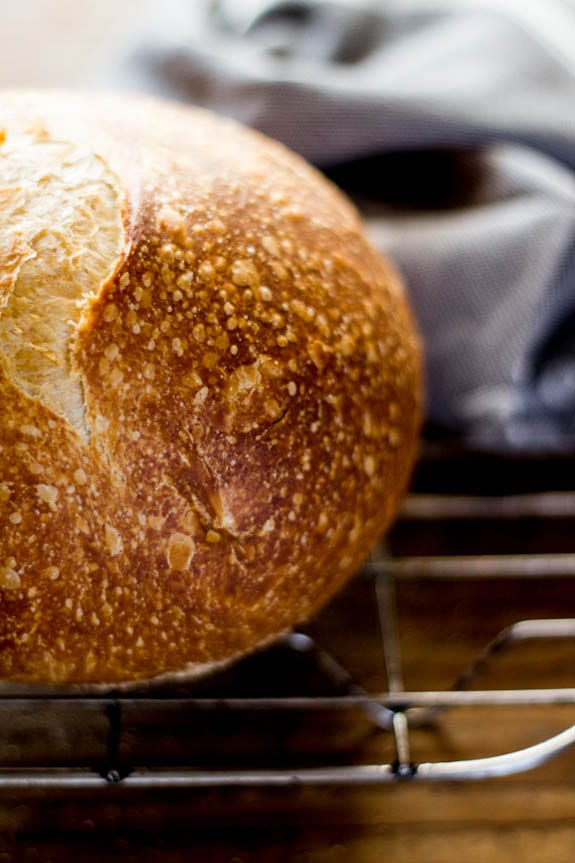
So, What is Sourdough?
In a nutshell, sourdough is slow-fermented bread.
It’s unique because it does not require commercial yeast in order to rise. Instead, sourdough bread is made with a live fermented culture a sourdough starter, which acts as a natural leavening agent.
Sourdough is known for its characteristic tangy flavor, chewy texture and crisp, crackly crust. From a health standpoint, it dominates when compared to supermarket loaves. The naturally occurring acids and long fermentation help to break down the gluten, making it more digestible and easy for the body to absorb. And it tastes darn good!
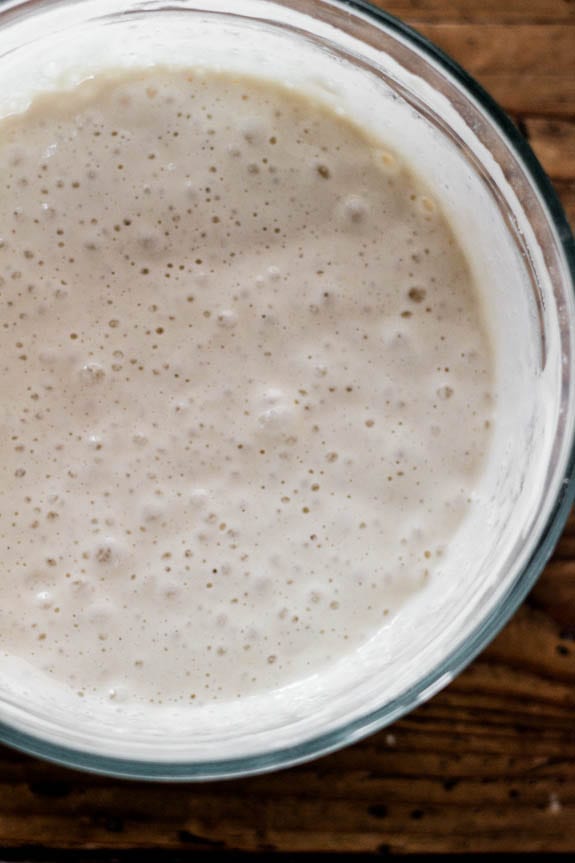
Sourdough Starter 101
Before you begin, you’ll need a sourdough starter.
Simply put: a sourdough starter is a live culture made from flour and water.
Once combined the mixture will begin to ferment, cultivating the naturally occurring wild yeasts and bacteria present within the mixture. A small portion of this culture is used make your bread dough rise.
But it doesn’t stop there.
Your starter must be kept alive with regular feedings of flour and water to maintain its strength for maximum rising power.
How to Feed your Sourdough Starter
Every baker has their own method, and with practice you’ll eventually develop your own routine.
Here’s my method: I pour off some of the culture (about half) and then feed what’s left in the jar with equal weights of flour and water. I whisk well with a fork until it’s lump-free. Then, I let it rest at room temperature or in a warm spot (75-80º F/ 24-26º C is ideal) until it becomes bubbly and active.
PS: I use this the jar for my sourdough starter and I LOVE it.
When is my Starter Ready To use?
Your stater is ready to use when it becomes bubbly and doubles in size.
This can take anywhere from 2-12 hours or more depending on temperature (the warmer the better) and the condition of your starter. Be patient!
Float Test: If you’re still unsure whether it’s ready to use drop a small amount, about 1 tsp, into a glass of water. Do this when the starter is a peak height before it collapses. If it floats to the top it’s ready to use. If it sinks, your starter should be fed again.
Where to Obtain a Sourdough Starter
All sourdough starters are different.
They can be made from scratch, purchased online, or if you’re lucky, someone will share a portion of their starter with you.
Starters range from thick to thin in texture and can be made with a variety of flours. I use two different starters; one is homemade and the other was a gift from my friend Celia. She dried a portion of her starter and mailed it all the way from Sydney, Australia.
How To Use A Starter
After you’ve fed your starter and it’s bubbly and active, pour the amount you need out of the jar to weigh or measure for your recipe. That’s it.
Then, don’t forget to feed what’s left in the jar with more flour and water to keep the process going.
Any leftover sourdough starter can be used to make sourdough discard recipes, even my homemade sourdough pasta.
Storage Options
If you only bake a few times a month, keep your starter in the fridge and feed it once a week. If you’re an avid baker, store your starter at room temperature and feed it at least once a day.
Looking for more info on sourdough starters? Check out Feeding Sourdough Starter: My Best Tips & Tricks & Sourdough Discard 101: Recipes & Faqs Answered.
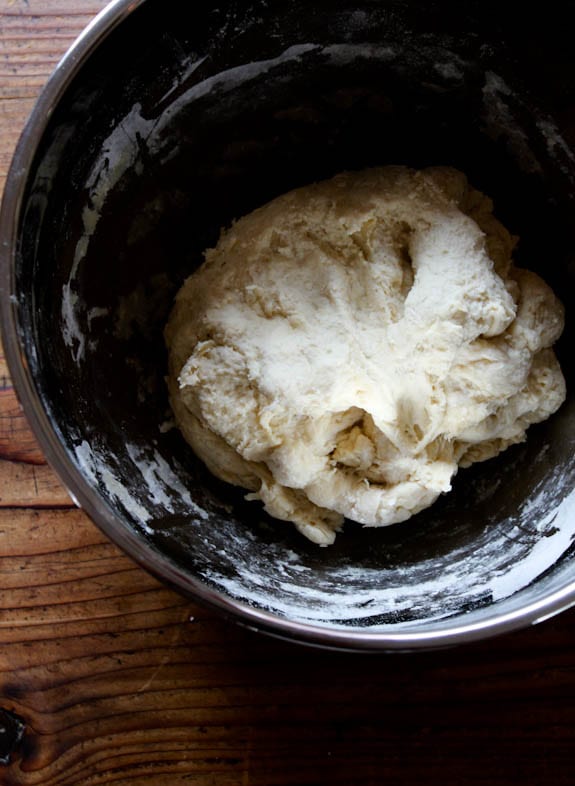
How to Make Sourdough Bread: Step-By-Step Guide
Step #1: Mix The Dough
Combine the following ingredients in a large bowl (I use a fork):
- 250 g water
- 150 g bubbly, active sourdough starter
- 25 g olive oil
Add:
- 500 g bread flour (such as King Arthur)
- 10 g fine sea salt
Squish the mixture together with your hands until the flour is fully absorbed. The dough will feel dry, rough and shaggy.
Cover the bowl with plastic wrap, reusable wax wrap, or a very damp kitchen towel and let rest or ‘autolyse’ for about 30 minutes. After the dough has rested, work it into a ball directly in the bowl (it doesn’t have look perfect).
TIP: For best results, weigh all of your ingredients with a digital kitchen scale. Measuring cups are not as accurate. Please visit Sourdough FAQ for more details.
What is Autolyse?
This is the first resting period right after you mix the dough.
It jumpstarts gluten development without kneading. Strong gluten = good bread.
For timing, autolyse can range anywhere from 15 minutes to 1 hour or more depending on the type of bread you’re making and your own personal baking schedule. A minimum of 30 minutes works best for this recipe. However, when time permits, I’ll let it go for an hour. The dough will become more soft and manageable to work with afterwards.
A Note on Salt: some bakers prefer to add salt only after autolyse because it might slow down the gluten development. I’ve followed this technique for years, but no longer do so. I prefer to mix everything all at once. It’s practical, effective and produces excellent loaves (plus, you won’t forget to add the salt later on!). I’ll leave the choice up to you.

Step #2: Bulk Rise
Now the dough is ready to rise.
Cover the bowl and let rise at room temperature, about 68-70 F.
How Long will it take?
The dough is ready when it has doubled in size and no longer looks dense.
This can take anywhere from 3-12 hours depending on your current room temperature, the potency of your sourdough starter and the specifics of your surrounding environment.
For example, in the summer the dough can take anywhere between 2-4 hours @ 85º F/ 29º C. In the winter, it will take longer about 10-12 hours @ 68º F/ 20º C. Temperature controls time.
And remember: because sourdough bread does not contain instant yeast it will take longer to rise. Watch the dough and not the clock. Be flexible.
Optional Step: Stretch and Fold the Dough
About 30 minutes into the bulk rise, you have the option to perform a series of ‘stretch & folds’ to strengthen the bread dough {click here for a step-by-step tutorial}. Although it’s not mandatory, this technique will add height and structure to the finished loaf and it’s fun to do.
Watch the video below!
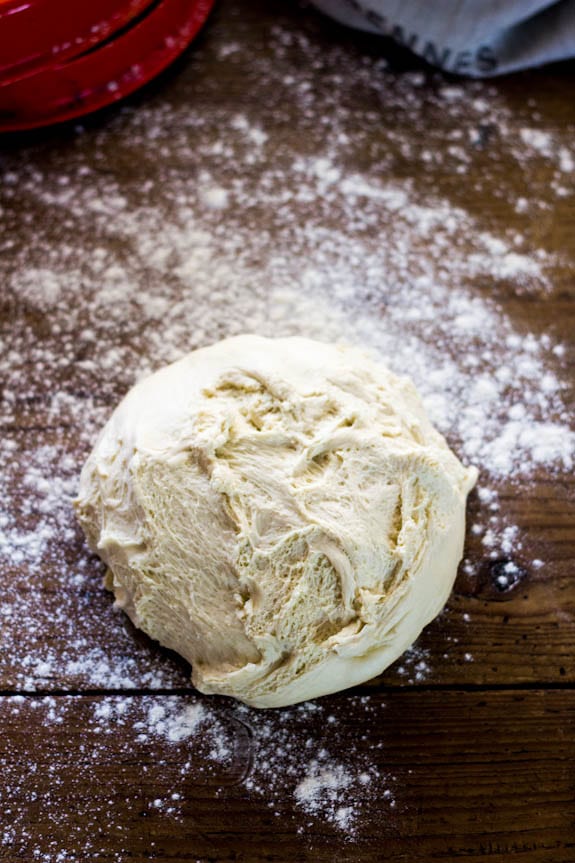
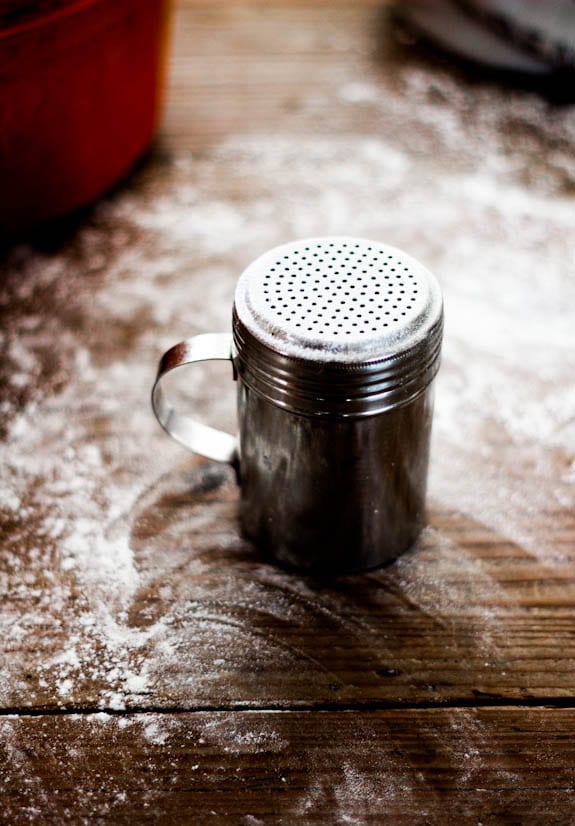
Step #3: Divide & Shape The Dough
Remove the dough onto a lightly floured surface.
Cut the dough in half to make 2 loaves, or leave it whole for a single loaf.
How to Shape a Round Sourdough Boule (Loaf)
Starting at the top, fold the dough over toward the center. Give it a slight turn, and then fold over the next section of dough. Repeat until you have come full circle. Or, use the envelope shaping technique outlined below.
Watch the video!
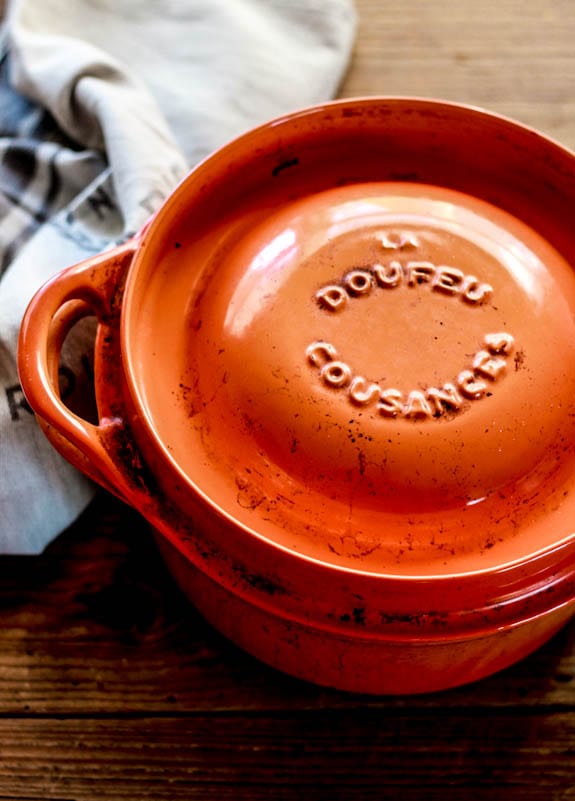
Step #4: Choose a Baking Pot
I bake my sourdough bread in a Dutch oven.
You can also try the Challenger Bread Pan, another vessel I use for baking, that can accommodate both round and oval shaped loaves.
The pot traps in heat and moisture which is essential to achieving artisan style bread at home.
Steam plays a key role in how the bread will open up or ‘bloom’ while baking and the Dutch oven helps to control this process.
You can use any oven safe pot that can heat up to 450º F/ 232º C (including the lid and handles).
TIP: In the past, I’ve tried baking on pizza stones and cookie trays with no luck. The crust would harden too quickly, forcing the bread to tear on the bottom and sides. I used various steaming methods to remedy this, however I found them to be extremely cumbersome and not realistic for everyday use. Nothing worked. The lack of moisture in my home oven was evident and using a pot for baking was the only practical solution.
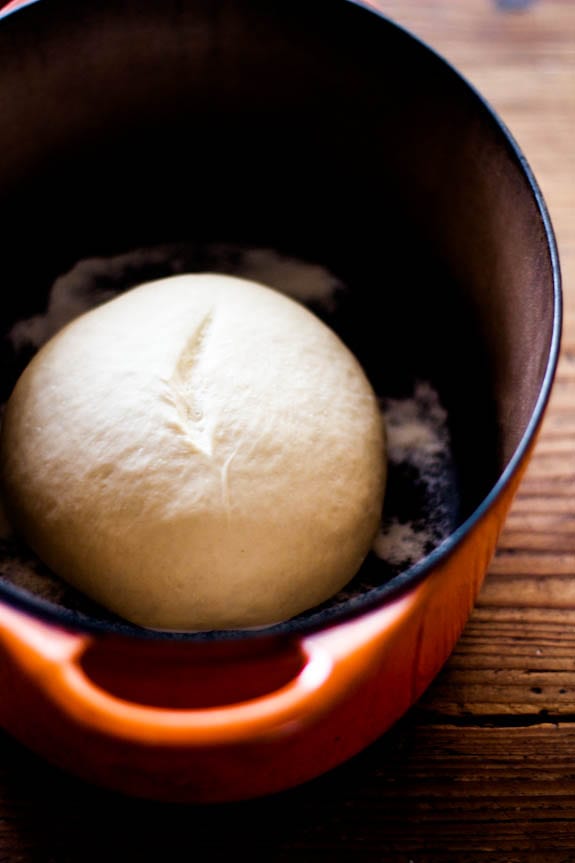
Step #5: Second Rise
After shaping the dough, it needs to rise again.
Generously coat the bottom of your Dutch oven with cornmeal (or line the bottom with non-stick parchment paper instead) and place the dough inside.
This time, the dough will rise for a shorter period about 30 minutes- 1 hour.
The dough is ready when it’s puffy and no longer dense. It does not need to double in size.
Preheat your oven to 450º F/ 232º C during the tail end of the second rise.
TIP: Instead of doing a free form second rise in the Dutch oven, use a cloth lined proofing basket or 8-inch bowl instead. Either option will contain the dough and hold its shape properly during the second rise.
Step #6: Score The Dough
After the second rise, and right before the dough goes into the oven, make a slash about 2-3 inches long down the center of the dough.
This allows the steam to escape and for the dough to expand during baking.
You can use a small serrated knife, paring knife or bread lame.
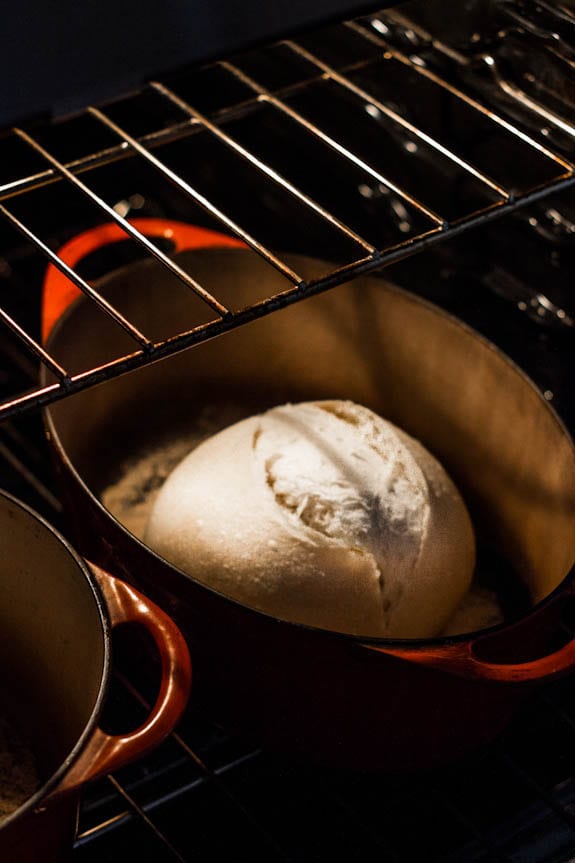
Step #7: Bake The Sourdough Bread
Place the lid on top of the pot and reduce the oven temperature to 400º F/ 204º C.
Bake on the center rack for 20 minutes.
When 20 minutes is up, remove the lid. Your bread will be pale and shiny like the picture above.
Continue to bake (uncovered) for an additional 40 minutes or until deep, golden brown. The internal temperature should read 205-210º F/ 96-98º C.
Cool on a wire rack for at least a 1 hour before slicing. Be patient!
If you cut into it too soon, the texture will be gummy…
TIP: During the last 10 minutes of baking, crack open the oven door (optional). This allows the moisture to escape, leaving your sourdough bread with a crisp crust. Alternatively, remove the bread from the pot and let it bake directly on the rack. The latter produces a more crisp crust.
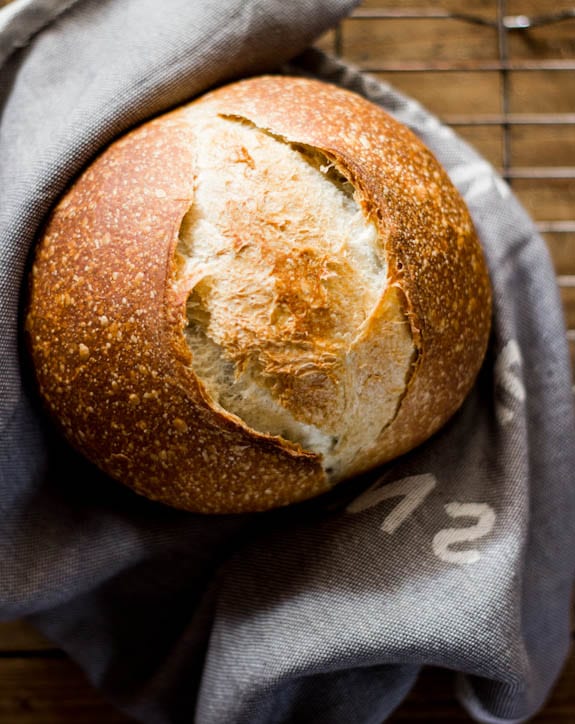
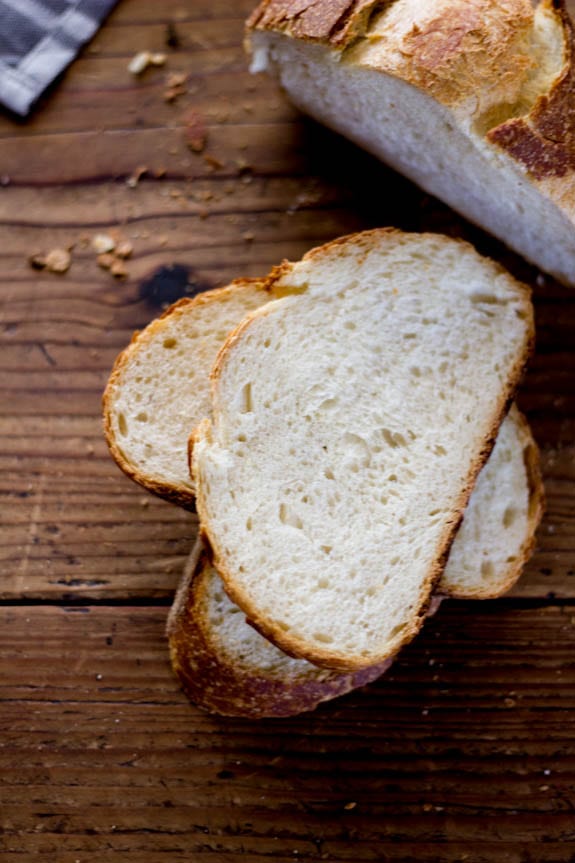
Additional Sourdough Recipes & Resources
Sourdough Starter:
- Beginner Sourdough Starter {Recipe}
- Feeding Sourdough Starter: My Best Tips & Tricks
- Sourdough Discard 101: Recipes & Faqs Answered
Sourdough Bread Recipes:
- Beginner’s Guide to Sourdough Focaccia Bread
- Best Sourdough Pizza Crust (No steel or stone!)
- Best Sourdough Pasta (1 hour or Overnight)
- Light Whole Wheat Sourdough
- Easy Sourdough Sandwich Bread
- Soft Sourdough Cinnamon Rolls
- Best Sourdough Pancakes
Sourdough Bread Tips & Techniques:
- How to Stretch and Fold Sourdough {Video}
- How to Shape a Round Sourdough Boule {Video}
- Why Won’t My Sourdough Bread Rise?
- Bread Flour vs. All Purpose Flour: What’s the Difference?
Sourdough Tools & Supplies:
Baking Schedule
- Friday Evening: Feed your starter, cover the jar, and leave it on the counter overnight. If you keep your starter in the fridge, it might need two feedings to perk back up (feed it in the morning & in the evening).
- Saturday Morning: Check your starter: if it’s alive and bubbling, you can make the dough to rise during the day. Or, feed it again in the afternoon to make the dough in the evening for an overnight rise. Remember to use the float test mentioned above to make sure your starter is ready to use.
- Saturday Morning/Evening (or whenever your starter is ready): Make the dough. Leave on the counter to bulk rise at room temperature. In the summer, if your dough rises quickly and you’re not ready to bake, cover the whole bowl with lightly oiled wrap and chill until ready to use.
- Sunday Morning: cut and shape the dough. Place in Dutch oven for second rise. Slash. Bake. Cool. Eat.
Sourdough Bread Recipe
Print
Sourdough Bread: A Beginner’s Guide
- Prep Time: 13 hours
- Cook Time: 1 hour
- Total Time: 14 hours
- Yield: 1 loaf
- Category: Sourdough Bread Recipes
- Method: Oven-Baked
- Cuisine: American
- Diet: Vegan
Description
This beginner sourdough recipe is perfect for bakers looking to jump right in! It’s is a low-hydration dough, meaning it will yield a ‘tight’ crumb (small holes). It is great for sandwiches and toast.
Ingredients
- 150g/ 5.35 oz bubbly, active sourdough starter
- 250g/ 8.80 oz warm water, preferably filtered*
- 25g/ .90 oz olive oil
- 500g/ 17.65 oz bread flour (not all purpose flour)
- 10g/ .4 oz fine sea salt
- fine ground cornmeal, for dusting
*For a more soft and pliable dough, you can increase the water up to 300 g- 325 g total. Please use a cloth lined bowl (instead of the Dutch oven for the second rise).
**You will need a 5 1/2 or 6 quart Dutch oven for baking
***This recipe was tested with King Arthur Bread Flour, Gold Medal Bread Flour, Pillsbury Bread Flour
Instructions
Make the Dough
Whisk the starter, water, and olive oil in a large bowl. Add the flour and salt. Squish everything together with your hands until all of the flour is absorbed. The dough will be dry and shaggy. Cover the bowl with plastic wrap, reusable wrap or a clean, very damp kitchen towel. Let rest (autolyse) for 30 minutes or up to 1 hour, if preferred.
After the dough has rested, work the dough in the bowl into a rough ball, about 15 seconds.
Bulk Rise
Now the dough needs to rise.
Cover the bowl with wrap or a very damp kitchen cloth. Let rest in a warm spot to rise. The dough is ready when it no longer looks dense and has doubled in size. This can take anywhere from 3-12 hours depending on the temperature of your ingredients, the potency of your starter and surrounding environment. For example, in the summer rise times can take anywhere between 2-4 hours @ 85º F/ 29º C whereas in the winter, the dough will take about 10-12 hours @ 68º F/ 20º C.
Optional Step: Stretch & Fold the Dough
During bulk rise, you have the option to perform a series of ‘stretch & folds’ to strengthen the dough. Start 30 minutes into the bulk rise. Gather a portion of the dough, stretch it upwards and then fold it over itself. Rotate the bowl ¼ turn and repeat this process until you have come full circle to complete 1 set. Do this once or twice spaced about an hour apart. Although this step is not mandatory, it will increase the total volume and height of your bread. Click here for a step-by-step video tutorial.
Cut & Shape the Dough
Divide your work surface in half; lightly flour one side (for cutting) and leave the other half clean (for shaping).
Remove the dough from the bowl, and place onto the floured section so that it does not stick. You do not need to ‘punch down’ the dough; it will gently deflate as you fold and shape it.
Cut the dough in half to make 2 loaves, or leave it whole for a single loaf.
To shape, use a bench scraper to move your dough to the non-floured section (if there is any flour present, it will be difficult to shape- brush away any excess). Starting at the top, fold the dough over toward the center. Give it a slight turn, and then fold over the next section of dough. Repeat until you have come full circle.
Then flip the dough over and place it seam side down. Using your hands, gently cup the sides of the dough and rotate it, using quarter turns in a circular motion. You can also pull it towards you to even out the shape. Repeat this process until you are happy with its appearance. *See note below.
Second Rise
Now the dough needs to rise again, but for a shorter period of time.
Coat the bottom of your Dutch oven with cornmeal. Alternatively, use parchment paper to prevent sticking (this is what I do, now). Place the dough inside for a second shorter rise, about 30 minutes to 1 hour and cover with the lid of the pot or a very damp cloth. The dough ready when it is slightly puffy but not double in size.
Preheat your oven to 450º F/ 232º C towards the tail end of the second rise.
Score the Dough
Right before your bread goes into the oven, make a shallow slash about 2-3 inches long (or more) in the center of the dough. Use a bread lame, sharp pairing or a small serrated steak knife. The cut should be about 1/4-inch deep.
Bake the Dough
Place the bread into the oven on the center rack (lid on) and reduce the temperature to 400° F/ 204° C. Bake for 20 minutes. Remove the lid, and continue to bake (uncovered) for an additional 40 minutes or until deep, golden brown. Keep in mind that all ovens are different; you might have to make minimal adjustments to these temperatures.
You can also take the internal temperature of your bread to double check that it is done. For sourdough, it should read about 205-210º F/ 96-98º C.
Remove the bread from the oven, and cool on a wire rack for at least an hour before slicing. Don’t cut too soon or else the inside will have a gummy texture!
Notes
When shaping, the idea is for the dough to catch enough surface tension on a non-floured area in order to create a tight ball. If there is flour present, it will slide around… and drive you nuts.
Sourdough FAQ
1.) I only have all purpose flour. Can I still make this recipe?
For best results, use bread flour for this dough. If you only have all purpose try my Artisan Sourdough with All Purpose Flour instead.
2.) Can I add whole wheat flour to this recipe?
You can, but I wouldn’t. The dough will be too dry and dense without adjusting the water quantity. Try my Light Whole Wheat Sourdough for more whole grain goodness.
3.) Your beginner recipe here uses 150g of sourdough starter. The Everyday Sourdough in your book uses only 50g. What’s the difference? And why?
- When I first learned how to bake sourdough bread, I used 150g of starter. Overtime, it was too much to maintain (especially when doubling and tripling recipes). So, I scaled down. That’s why most recipes in my book Artisan Sourdough Made Simple include 50 g of starter instead. One amount is neither right or wrong; it’s just a matter of preference.
4.) What’s the purpose of olive oil in this recipe?
Adding olive oil to sourdough was the method I followed when I first learned how to bake. The natural fat emulsifies the dough and makes a plush crumb.
5.) Why do some of your recipes call for the second rise in a Dutch Oven? And others in a cloth- lined bowl?
The freeform Dutch oven second rise will only work with dry, low hydration doughs (like this one) because it will not spread out too much. On the flip side, when working with wet, high hydration doughs you’ll need to use a cloth-lined bowl sprinkled with flour to holds it shape. Otherwise, it will spread.
6.) Why don’t you preheat your Dutch oven before baking?
Because this recipe follows a freeform second rise directly in the baking pot, it cannot be preheated beforehand. The dough will begin to cook before going into the oven!
However, if you are doing the second rise in a cloth-lined bowl as mentioned in question #5 above, you can preheat the pot if you’d like. When bread dough is placed into a hot pot it begins to expand instantly which is great for the overall shape and structure of the bread. And in fact, I use to follow this technique when I first started baking. But overtime, I found the preheat to be too cumbersome for small kitchens with little kids running around. Plus, I kept burning my wrists. Long story short: you can achieve comparable results without the preheat. The choice is up to you.
7.) Can I halve the dough to bake 2 loaves? If so, what will that do to the baking time?
Yes, you can definitely halve this recipe. Bake for 20 minutes (lid on) and 30 minutes (lid off). Check at the 45 minute mark.
8.) If I halve the recipe, where should I store the second dough if I’m not baking at the same time?
Store the second dough in the fridge until ready to bake. Place the dough in a cloth-lined floured bowl (seam side down) and use the cloth overhang to cover it. If the dough is in the fridge for longer than 1 hour, rest at room temperature while the oven heats up.
9.) How do I get the dough out of the cloth-lined floured bowl?
Open up the cloth overhang to reveal the dough in the bowl. Place a piece of parchment paper on top of the dough. Flip the bowl over. Remove the bowl and cloth. The dough is now smooth side up and ready to be scored.
10.) Can I have the measurements for this recipe in cups, please?
- 3/4 cup bubbly, active starter
- 1 cup + 1 tbsp warm water
- 2 tbsp olive oil
- 4 cups bread flour
- 1 1/2 tsp fine sea salt
NOTE: Weight and volume measurements are not equivalent, only approximate. I strongly recommend weighing your ingredients instead. With that said however, I understand the convenience of measuring cups. For best results, please aerate the flour first (I fluff it with a fork directly in the bag), then lightly spoon and level it into the cup. Too much flour will make the bread dense. If your sourdough starter is very bubbly, the volume amount might be off. If necessary, add up to 1 cup as needed. Finally: the water can be increased up to approximately 1 1/3 cups, for a more soft and pliable dough.
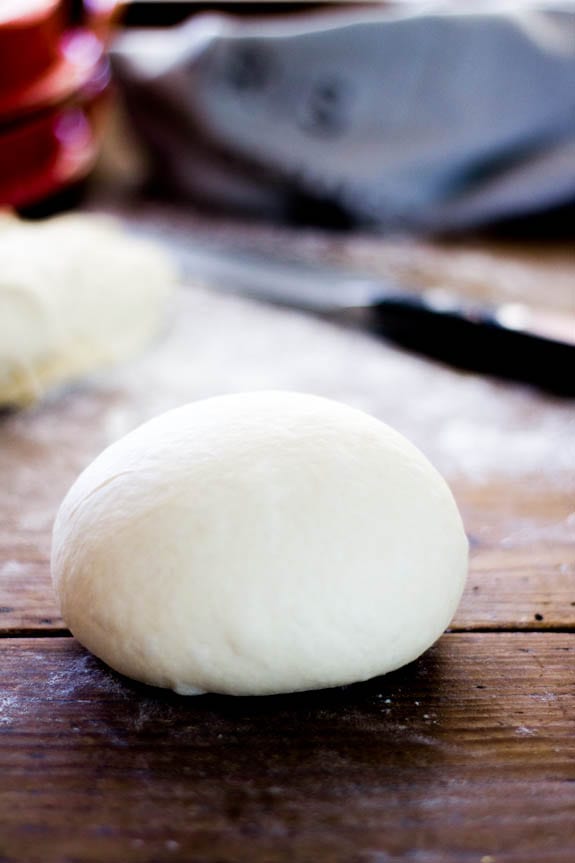
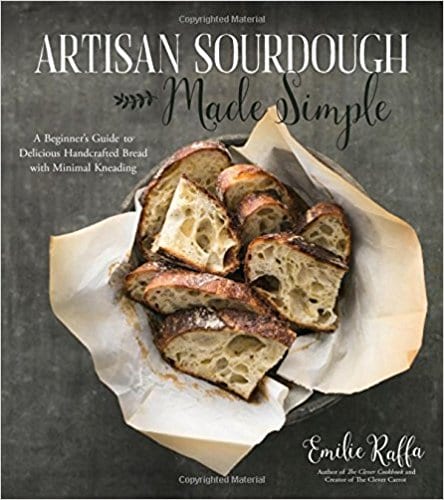


Comments
Bunny Cohen says
I used this recipe and my bread turned out amazing.
Emilie Raffa says
Thrilled to hear this! Thanks for your feedback :)
John Holmes says
Made my dough and forgot to add salt!
Abby says
Love this recipe so much! It helped me make my first successful sourdough loaf. It tastes amazing and was such an easy consistency to work with. My family loves it. This will definitely be my go to recipe for a while. Thank you!
Emilie Raffa says
Excellent. Thanks so much for taking the time to comment, Abby. You are on your way!
Maria McNeilly says
How long would it take to make this recipe in a Conventional oven?
Emilie Raffa says
Hi Maria! To clarify, do you mean convection? This recipe is written to work with conventional/regular oven temp. Thanks!
Nelson Oscar Riveros Escanuela says
I tried with many differente receipts until I found this. Just perfect.
Emilie Raffa says
Thank you! I’m so glad it was successful for you :)
Karina says
Hi,I baked my first sourdough today. I followed the recipe given, I left my dough overnight to rise. When it came to shaping, I noticed the dough was very soft and stretchy, but wasn’t holding its shape.
On baking, it browned far faster than the time stated, so I had to remove it from the oven. It was quite flat, when I have broken it, it’s very aerated, but not really baked through. I wonder 2 things, was it left too long for the first rise? Or was there too much water added at the start?? TIA
HD says
Is a food scale necessary? Are the measurements avail in cups?
Suzie says
It worked beautifully! Lovely.
Gary S. says
I’ve been baking Artisan style breads now for about 6 years. Everything I’ve learned about sourdough bread over that time is pretty much found right here in this very comprehensive guide. This is great reference material.
Victoria says
I’m decent at baking, no expert but I can follow a recipe. I’ve NEVER made bread before and this turned out amazing! I had a starter that was about a week old, but I even used all purpose flour. This recipe is fool proof!
Dennnis Cotto says
Excellent! I followed step by step and my sourdough bread came out delicious! Thank you!
Jessica says
Hi, I was wondering if it is possible to do the second rise, in the proofing basket in the refrigerator to slow it down? If so, now long would you recommend to leave it in the refrigerator? Would you then bring it to room temperature before baking?
Thank you!
Heather says
How long can you safely leave the dough out to raise? I have left it out 24+ hours because that’s how long it took to double in size. Is it still safe to eat?
Mandy says
What size dutch oven do you recommend?
Matt says
This was my second time makeing sourdough bread and this recipe was spot on. I used my ovens proofing option to speed up the process, took about 3 hours. Bake time was spot on, texture and flavor was great!
Megann says
When you feed your starter for this recipe, what ratio do you use?
Joan Rond says
This was my first time ever to make sourdough bread and much to my delight and surprise it was delicious. I’m going to make another loaf today. Can’t wait to try the pancake discard recipe. Thank you Emilie.
Denise says
What is the best way to store it! Mine was a little flat but tasted good..
I realized i was not using bread flour but for my first try it was good..Now
to try with better flour.
Rosy poesy says
On my first rise after all my stretch and folds if the dough hasn’t doubled yet can I refrigerate it for bulk rise overnight? 😊
Emilie Raffa says
Yes. Chill overnight. In the morning, let it rise more at room temperature!
Rose Loboda Johnson says
Thanks so much!!! Your awesome 🤩
Gabriella says
Hi Emilie, would love your help / suggestions with a sourdough challenge I’ve been having.
This is the 2nd basic sourdough loaf recipe I’ve tried. Both times my dough has been tight, damp, and non-elastic – like silly putty. Stretch and folds are difficult since it’s not super stretchy to begin with. It hardly rises during the bulk rise (which I do in the oven with the light on since the house is cold) even if left 12+ hours. Then when I poke it, it doesn’t spring back. When I bake it, it rises just a little. It’s edible, but definitely more dense and chewy than it should be.
I measured exactly using grams, warm filtered water, and the correct flour. The issue can’t be my starter, either – I’ve made sandwich loafs and english muffins which both turned out well.
I’m thinking the issue is either too much water (newbie here – how do I know when I have too much?) or perhaps not kneading enough before the bulk rise (are you supposed to knead sourdough, or just stretch+fold)?
Any insight would be so so helpful. I feel like I just keep wasting flour!
Josh says
Did you sort any of this out? I see that Emilie hasn’t replied.. mind if I offer some of my tips? Huge props to the people that nail the baking process right off the bat ~ because sourdough can take a lot of time for many people to learn (felt like it took me forever). The best thing I can recommend (if it’s not working) is to learn more about each step of the process and don’t give up. The results definitely pay off in the end!
Colder temperatures = longer fermentation periods. 150 grams of starter is enough to make almost anything ferment in a 12 hour period ~ pending it’s not too cold (too cold might be 13-17 degrees celsius for this ratio). I base my recipes off of a hydration level that excludes the amount of starter I’m using.. only because I’m not patient enough to math it out properly. Here’s what I’m saying: for me, I would consider this recipe (250g of water, and 500g of water) a 50% hydration level. I don’t worry about how much the starter affects the total hydration. My minimum hydration is always 65%. So for the recipe, I’d use a minimum amount of 375 grams of water to 500 grams of flour. Then, if I found it fermented quicker than I wanted in 12 hours, I’d reduce the starter (because 150g of starter is typically a lot for a 500g of flour loaf size, for me anyway). I think 75 grams of starter would be sufficient with a 65% hydration loaf to ferment in 12 hours at 21-23 degrees celsius (sorry, I don’t know fahrenheit). And you can always experiment with greater hydration levels, just note that the greater the hydration, the more interesting the dough is to work with. Just trying to be helpful.. I love sourdough!
Gabriella says
Thank you so much for your kind comment Josh! I really appreciate you taking the time to share your experience and advice. I’ll have to read through it a couple times to really digest it but I am excited to try these tips for my next loaf!
Rochelle Morrow says
Gabriella, I had the exact thing happen with mine today. I doubled the recipe and fed my starter heavily tonight to try again at a higher hydration in the morning. That way I can compare workability. I do remember my loaves in 2020 using this recipe turned out dense but tasty.
Josephine says
Hi, I am having so much difficulty with my starter. I tried to use it 6 months ago and fed it several times. I thought the starter was okay so I used it to bake sourdough bread and the bread did not work out. I had a huge separation between the crust and the bread and the bread was not thoroughly cooked. Now I took it out of the fridge, 5 months later, and am trying again. I took the starter out of the fridge last Saturday and fed it twice. Then twice on Sunday. Then once every day since Sunday. I am using warmer water and am keeping it in a warm location. I get a few bubbles and that is it. I use rye flour for my starter. What should I do? Thank you so much.
Sarah says
I used to use rye to feed my starter when I first started it 3 years ago and had the same thing… not a lot of bubbles. From what i have been able to gather you will not get the same bubbly reaction with rye and it will always produce a denser dough. Maybe if you have a recipe you want to try take a little but out of your fridge starter and put in a new container and feed that one with unbleached bread flour and use that to bake your bread with. I started getting better results when I started using unbleached bread flour. You could also experiment with feeding with half rye half if the bread flour also. See if you get better results.
Josephine says
Thank you so much. I will try the white flour.
Chelsey Klinge says
I am new to sourdough, and have your website saved on my home screen on my phone, for easy access. I’ve used this recipe for a base for inclusions as well. It’s worked great! It’s just, every video I would see of sourdough making, my dough was never as pliable during the stretch and fold. I have a loaf I am baking in the morning, and I increased the water to 300 grams, and followed everything else to an T, and it’s going to be perfect! I can’t wait!
Megan says
My go to recipe! Thank you!
Terry says
Hi…I’ve been making my own yeasted sandwich bread, rolls etc. for 20+ years, but I’ve NEVER attempted sourdough as it was always one of those “sometime” things. Recently I’ve realized that commercial yeast is a recent development (duh) and may well be partly responsible for the current misunderstandings about bread and gluten in general. I have two questions:
1) If the point of sourdough is “slow rise”, what is the difference in the result if one simply uses less yeast? I’ve been cutting the amount of yeast (active dry, not rapid-rise) in my whole-grain breads by 3/4 to effect a slower rise = better texture and flavor, so that it takes 4-6 hours for the first rise and 2-3 for the second.
2) If the sourdough method breaks down the gluten, how does the bread rise? Or are we talking shorter gluten “chains”? Or does it simply rise less?
In any case it’s good to know I can make my own starter and possibly have my first loaf in a day or two!
Gen says
Hi just wanted to ask is there any reason why after 1hr autolyse my dough still seem dry and not stretchy?
Emilie Raffa says
Hello! It depends on the amount of water you added (I’ve given a range). More water + adequate resting time = stretchier dough. Temperature is also a factor. In your case, if you want stretchier dough, just let it rest more and/or move it to a warm spot (inside the oven, turned off, with the light on is a good spot).
Bobbie says
Hi! I used blood orange-infused olive oil and it is awesome. Next time I will bake it 5 more minutes to get an extra crunchy crust.
Emilie Raffa says
Bobbie, you are the first to do this and I think this tip is AMAZING! I bet lemon oil would be great too. Thanks for sharing :)
Lori E says
You are a light at the end of this sourdough tunnel. I have not yet even started on this journey. A friend is mailing me some starter, but I was already starting to talk myself out of trying this as the online discussions and descriptions were overwhelming with sourdough “lingo” and rules.
I am a very experience cook and have done lots of baking and had never come across such a complicated process for anything before.
Then I came across you site and you made sense. You explained things in a normal way that anyone who can read could also understand. Your videos were perfect. Exactly the right amount of instruction paired with very clear actions.
I am being honest here when I say if it were not for this post I don’t think I would have ended up trying to do it when my starter gets here.
Thank you.
Heather Alsobrok says
THIS site has got me addicted to Sourdough EVERYTHING! Seriously. I have loved baking my whole life and I always wanted to experiment with sourdough, but this site has be making everything sourdough! I’ve made the bagels 3 times, I’ve made so many sourdough baguette’s, sandwich bread, pancakes, I made some hamburger rolls that turned out amazing. I’m going to try some sourdough cider donuts next. All I can say is thank you, I’m going to tag you on Instagram with some of my bread photo’s.
Nicky Scozzaro says
Your sourdough starter recipe makes 120g of starter, yet your recipe calls for 150g of starter. It would be nice if your sourdough starter was e.g. 300g so that half could be used for the sourdough bread recipe and the other half could be fed to continue the starter.
Tara says
Hi Nicky.
My math might not be quite right, but I think you end up with enough. I did, so I hope I’ve followed directions correctly.
Day 1 is 60g + 60g
Then Day 3 is half of this – because you discard half plus 60g flour & 60g water so 180g total.
Day 4 is 90g (half of 180) + 60g flour + 60g water so 210g total.
And so on. 🙂
Emily says
Thank you for the lovely sourdough starter recipe and the beginner sourdough recipe, I’ve really enjoyed the process! So far I’ve made 3 batches of sourdough bread, and a sourdough discard apple cake, so yummy! I’m now ready to branch out a bit and would love to add in some roasted garlic or Kalimantan olives to my sourdough. Are there any tips that you could pass on? Or just fold them in after first bulk rise? Thanks in advance.
Emilie Raffa says
Hi Emily! (I instinctively want to call you Em, because that’s what everyone calls me, lol). Oh yes- roasted garlic is FABULOUS in sourdough. Olives too. I have a recipe in my book. But here, you’ll want to fold the add-ins into the dough after the first rest (autolyse), not the bulk rise. Doing that latter will deflate the dough. You don’t want that. Enjoy!
Leah says
Love this recipe! I’ve baked 5 or 6 loaves so far and they come out perfect! Thank you. I would love to post a pic because they look just spectacular!
Emilie Raffa says
Excellent! This is incredible, Leah. Thanks for sharing! You can always tag me w/ pics on IG @theclevercarrot :)
Geraldene says
Thank you so much – there is so much confusing ‘expert’ advice online which resulted in my fiddling and fumbling around having hit and miss successes with my loaves. Your recipe is a game-changer!
Emilie Raffa says
Thank you, Geraldene. I totally agree. This was my problem when I first started out. There is so much conflicting information out there, all leading to the same result, which hopefully is good bread! So simple is best to start. Im my experience, I’ve found that one you build a solid foundation of the process, branching out and experimenting makes more sense later on.
Lauren says
THIS is my ‘go to’ sourdough recipe! It’s the one I have the most confidence in if I’m gifting a loaf of bread to a friend- I know it will ALWAYS turn out good. Thanks for sharing this wonderful recipe.
Emilie Raffa says
You are very welcome Lauren! Thanks for sharing your feedback- I’m glad you love it!
SW says
I have never left a comment or review on any site before but felt compelled to here. This was my first time ever making bread and by following your step by step sourdough recipe it turned out beautifully! Thank you for all the work you put into your post to make things easy for newbies like me;)
Emilie Raffa says
Thank you so much for the kind feedback. I’m thrilled to hear that your bread turned out successfully! xx
Nichole says
This is the first time I’ve used oil in a loaf and am thrilled with the results. Soft and delicious, great crumb and crust. I did a long cold ferment (78hrs) as I love the sour tang and baked it my usual way in a heated DO – lid on 30 mins @ 220 / lid off 20 mins @ 200. (I’m still a newbie and was a bit scared to try a different bake method after waiting 3 days!) However I’m very keen on trying different methods so am using your recipe again today and will try a cold DO bake. Many thanks for sharing.
Carol says
We mill our own wheat flour at home. What process makes light whole wheat flour?
To make whole wheat sourdough bread how would the flour and water grams be adjusted.
Carol says
I have followed your recipe and my dough doesn’t rise. I am an adamant baker and something isn’t working. I’ve done both ways stretch n pull and without and my dough doesn’t rise. My starter is bubbly and wonderful so what’s the problem.
Dennis O'Flynn says
Hi Emilie,
I’ve been mainly unsuccessful making sourdough for 10 years plus.
I’ve used many websites, (even yours) but just could not pull off a great result. Possibly my expectations are too high.
Just reading through your beginner’s guide I spied some changes. the main one being not too preheat the Le Cruseut. The other, not to do the bulk ferment in the fridge.
Admittedly I had to arise at 3 am to check the bulk rise (overnight in Newcastle (OZ) it was 15C, and the rise was more than double.
So, a quick shape and into the Le Cruseut on parchment.
Getting up at 6 am the second rise was complete, so a quick preheat and into the oven at 6:30.
A really great result, apart from the lame not slashing deep enough, but very happy, thank you.
Dennis
Alayssia says
Hi! Can I use this same recipe with a gluten free starter & gluten free flour?
Sarah J says
I used this recipe but used what I had, All Purpose Flour. I’m sure the bread flour makes a different loaf but I was AMAZED with how this came out still.
My first ever sourdough and it was restaurant-ish quality in taste and texture. It was so simple too! Family and I were completely shocked and taste tested half the loaf. I have a feeling ill be using this recipe a lot.
Khrystyna says
Delicious bread, great recipe. It’s my favorite now.Thank you
Emilie Raffa says
You are very welcome. Thank you 🙏
Evan D. Garner says
I’ve enjoyed several of your recipes, including this one. I’m curious why there is so little kneading in this recipe. If you were to knead for 5-7 min. after autolyse and before bulk rise, would you get a tough, too-chewy loaf?
Emilie Raffa says
Hi Evan! You are more than welcome to knead, if you prefer. And yes: do it after the autolyse step. Your loaf won’t become tough or chewy from the actual kneading step; those characteristics are mostly related to variables (i.e fermentation or rise time, handling, shaping, temperature, flour selection and water quantity. Bottom line: knead the dough, but it won’t guarantee a perfect loaf. Consider all variables!
Janine Jackson-Brown says
My starter isn’t rising can you help?
Malia Reiter says
I’m in the Autolyse step. Do this make one loaf for a SD Bread oven? Inexpensive never used this SDBO before.
Thank you,
Nathan R says
This is the recipe I used to make sourdough for the first time and it turned out great! Thank you! I am not sure if this question has already been answered yet but is it possible to use a different fat other than olive oil? Maybe butter or ghee?
Emilie Raffa says
Hi Nathan! Great question. Olive oil adds a unique, plush texture to the interior crumb. It’s very specific. So adding another fat like butter or ghee would work, but the texture won’t be quite the same because they are different fats. It’s definitely worth trying if you are into it. Let us know how it goes :)
Donna Steslow says
I’m going to try to slow the rise in the fridge overnight-it’s a very warm October day and the timing will be too late to bake tonight even if it’s only 2-3 hours (it’s so hard to time my baking with other things lol). I’m thinking it will work as it does with other recipes, hopefully.
Emilie Raffa says
Hi Donna! Yes, you can absolutely do that. Slowing down the rise in the fridge is a great way to adjust your baking schedule based on time and temperature. Totally works. My baking schedule always changes with the seasons! PS: an overnight bulk rise (in the fridge) should work with other recipes too, it just depends on the specific recipe. For example, an enriched dough made with a lot of butter won’t rise much in the fridge, so you’ll need to calculate extra rise time when you’re ready to continue at room temperature. Just keep that in mind as you continue to experiment. There’s always a learning curve with sourdough ;)
Cindy Bailey says
I’m trying a starter for the first time! I’ve already messed up. I forgot to discard and just did my first feeding. Should I start over?
Jennifer says
No. Don’t start over. Just feed it when it’s time. It will be just fine.
Jessica Snow says
The only reason for discarding is to keep a manageable amount of starter. Never save your discard or use your starter for the first 10 days. The bad bacteria is still there until around day 10. Hope this helps <3
Emilie Raffa says
Hi Cindy! No need to start over. Just feed it again, and moving forward, try to stay consistent with the feeding time each day. A feeding schedule will train your starter to rise and fall predictably so you know when to use it.
Macky Miller says
My bread was outstanding. It was my first attempt baking a Sourdough Bread and I was so excited with each step along the way. I have one question: can this same dough be made into
Sourdough Rolls?
April says
Hi,
I use cupcake pans sometimes so I can portion out and freeze. I weigh out around 100g per muffin. Making 1-2 big loaves for my husband and I is too much. When you defrost the bread will lose its crusty texture and toast it on a Breville. This warns it up, toasts it and gets done of that texture back.
Macky Miller says
Thank you so much. When you have time can you please tell me what temperature for the oven and how long to bake the rolls.
Most appreciatively,
Macky
April says
Macky
I start at 220C for 20min and then drop to 208 C for rest of the time.
It’s really depends on your oven but in most recipes you cover and at higher heat for 20 min, decrease temp and uncover for remainder of time.
Macky Miller says
Thank you so much.
Echo says
Hi
I start 220 for 20 min and then drop temp to 180c.
Emilie Raffa says
Wow! This sounds incredible. Excellent, excellent idea. Thank you for sharing this tip with us :)
Colleen says
This is my third recipe that I tried for sourdough. It is by far the easiest of the doughs to work with and hold its shape. Wonderful soft texture. Great crust. I really enjoyed this recipe and the great bread that it produced. Thank you!
Emilie Raffa says
Hi Colleen! Great to hear, thank you. I specifically designed the dough this way, with ease and practicality in mind. To me, that’s what it’s all about :)
Nitrous says
great recipe!
One point to keep in mind though is “don’t add salt to the starter/oil/water mix” ‘cuz it will form a gloopy mess!
Follow the order – it matters :)
Doug
Karen says
During the second rise my dough flattened out to The width of the Dutch oven? Help!
Emilie Raffa says
Oh no! This can happen sometimes. Possible causes: too much water in the dough, flour not strong enough, dough left for too long etc. To remedy this, I recommend using a proofing basket (instead of the Dutch oven) for the second rise. The basket will contain its shape while the dough rests.
Brian says
Is it really just 250ml of water? My math says that works out to 56%. That doesn’t sound right. Is it supposed to be 350?
Emilie Raffa says
Hi Brian! Yes: 250 g is correct. Sourdough bread can be low hydration or high hydration (low hydration is easier for beginners because the dough is more manageable). It really depends on the recipe you’re following. If you’d like to work with a higher hydration loaf, feel free to add additional water, up to 350 g, to this recipe.